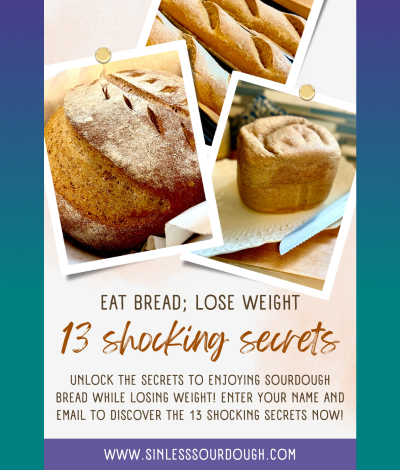Discover the Joy of Sipping Non Alcoholic Beer

Non alcoholic beer has emerged as a refreshing alternative for those seeking the rich flavors of traditional brews without the effects of alcohol. This growing market segment offers a wide range of options, from crisp lagers to hoppy IPAs, all crafted to mimic the taste and experience of alcoholic beer without the intoxicating effects.
My personal journey into the world of non-alcoholic beer began during a trip to Boston with my husband Shawn to attend an NBA game. While dining at a restaurant near the stadium, I noticed a non alcoholic option on the menu – Athletic Brewing Company’s offering. Despite being slightly higher in carbohydrates than I preferred, I decided to try it as an alternative to water or tea.
The experience was revelatory; I found myself thoroughly enjoying the complex flavors and satisfying mouthfeel of this craft non-alcoholic brew. When alcohol was part of my life I rarely drank beer because it always made me feel bloated. And the ongoing need to burp was annoying.
Upon returning home, I embarked on a mission to explore the variety of low-sugar non-alcoholic beers available in local grocery stores. Through this exploration, I discovered a pattern: IPAs consistently offered the lowest carbohydrate content among non-alcoholic options. This finding aligns with the brewing process for these styles, which typically results in a drier, less sweet final product.
What Is Non-Alcoholic Beer?

Brewing Process:
The production of non-alcoholic beer involves various techniques to reduce alcohol content, including:- Limiting the malt/water ratio during mashing.
- Using lower fermentable materials to achieve higher dextrin content and lower ethanol levels.
- Diluting finished beer with deoxygenated water to achieve the desired alcohol level.
- Controlling fermentation processes to inhibit alcohol production while retaining flavor.
Market Trends:
The market for zero-alcohol beer has been growing, with sales increasing due to changing consumer preferences towards healthier lifestyles and stricter regulations on drinking and driving. Major breweries have started to invest in NA beer production, recognizing its potential for growth. In some regions, like Spain, non-alcoholic beer sales have reached significant proportions, accounting for about 8% of total beer sales.Benefits and Considerations:
Non-alcoholic beer allows you to enjoy social situations without the effects of alcohol, making it a suitable option for designated drivers or if you are, like me, abstaining from alcohol for health or personal reasons. However, it is essential to note that, despite the low alcohol content, it may trigger cravings for those recovering from alcohol dependence.How Is Non-Alcoholic Beer Made?

Ingredients:
Like regular beer, non-alcoholic beer is made from four main ingredients:- Water: The primary component of beer.
- Grains: Typically malted barley, which provides fermentable sugars.
- Hops: Added for bitterness and aroma.
Yeast: Responsible for fermentation, converting sugars into alcohol and carbon dioxide.
Methods of Production:
1. Controlled Fermentation:
This method, also known as “arrested fermentation,” involves fermenting the beer normally but stopping the process before significant alcohol is produced. This is achieved by maintaining a lower fermentation temperature (around 60°F), which limits the yeast’s ability to convert sugars into alcohol. The result is a beer with very low alcohol content, typically under 0.5% ABV.2. Dealcoholization:
Dealcoholization is the most common method for producing non-alcoholic beer. It involves brewing beer normally and then removing the alcohol. There are several techniques for this:- Steam Distillation: The beer is heated, causing the alcohol to evaporate since it has a lower boiling point than water. The vapor is then condensed and removed.
- Reverse Osmosis: This method uses high pressure to push the beer through a semipermeable membrane that separates alcohol and water from flavor compounds, allowing the flavors to be retained while removing the alcohol.
- Vacuum Distillation: Similar to steam distillation but performed under reduced pressure, which allows for lower temperature processing, thereby preserving more flavor compounds.
3. Dilution:
In this method, water is added to finished beer to reduce its alcohol content. This can be done after fermentation, where the alcohol level is diluted to below 0.5% ABV. Typically, around 10% water is added to achieve the desired alcohol level.4. Simulated Fermentation:
Some brewers opt to skip the fermentation process entirely. Instead, they use ingredients and enzymes to mimic the flavors and characteristics of beer without actually fermenting the sugars. This method can produce a beverage that resembles beer without the complexities of fermentation. This can be referred to as hop water. It’s also a delicious beverage with usually zero calories and zero carbs. Ideal for our lifestyle.Does Non-Alcoholic Beer Contain Any Alcohol?
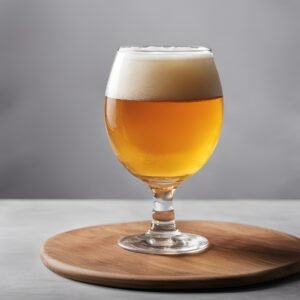
Non-alcoholic beer can contain small amounts of alcohol. In the United States, it is legally defined as any malt beverage that contains up to 0.5% alcohol by volume (ABV). This means that while non-alcoholic beers are designed to have very low alcohol content, they are not completely free of alcohol. Some brands may advertise themselves as having 0.0% ABV, indicating that they contain no detectable alcohol, but this is not always guaranteed. Studies have shown that some beverages labeled as alcohol-free can still contain trace amounts of alcohol, sometimes exceeding the stated levels.
Thus, individuals who need to avoid alcohol entirely, such as pregnant women or those with a history of alcohol dependency, should exercise caution and consult with a healthcare professional if they have concerns about consuming non-alcoholic beer. If you are recovering from addiction, stick to hop water rather than beer that has undergone de-alcoholization.
Can You Get Drunk From Non-Alcoholic Beer?

Non-alcoholic beer (NA beer) typically contains very low levels of alcohol, usually up to 0.5% alcohol by volume (ABV) in the U.S., compared to around 5% ABV for regular beer. This minimal amount of alcohol is insufficient to cause intoxication in healthy adults. At least from my perspective.
However, some individuals report feeling a sense of buzz or lightheadedness after consuming non-alcoholic beer. This phenomenon can often be attributed to psychological factors, such as the placebo effect or social conditioning. For instance, the sensory experience of drinking beer—its taste, smell, and the context in which it is consumed—can trigger associations with past drinking experiences, leading to feelings of relaxation or euphoria that mimic intoxication.
Despite these reports, the consensus among experts is clear: while non-alcoholic beer can create an impression of drunkenness, it cannot chemically induce a state of intoxication due to its low alcohol content. Drinking large quantities of NA beer may theoretically result in a very small amount of alcohol consumption, but it would require an impractically high volume to approach the effects of regular beer.In summary, while you may feel a bit “buzzed” from non-alcoholic beer due to psychological effects, it does not contain enough alcohol to actually get you drunk.
How Does Non-Alcoholic Beer Taste?

Here’s an overview of how non-alcoholic beer typically tastes:
Flavor Profiles:
Non-alcoholic beers can vary widely in taste, depending on the brewing process and style:Lager:
Non-alcoholic lager often aims for a crisp, clean taste with subtle malt sweetness and a hint of hops. For example, Partake Brewing offers a Blonde Lager as part of their non-alcoholic beer lineup. This lager is characterized by its refreshing and easy-drinking profile, making it a great option for those seeking a low-calorie beverage. Partake Brewing offers a Blonde Lager as part of their non-alcoholic beer lineup. This lager is characterized by its refreshing and easy-drinking profile, making it a great option for those seeking a low-calorie beverage. It contains only 15 calories and 3 grams of carbohydrates per 355 mL can. The Blonde Lager features a crisp, golden appearance with a light layer of white foam. Its aroma is surprisingly hoppy, with floral and bitter pine notes, along with a hint of sweet malt.Indian Pale Ale (IPA):
Non-alcoholic IPAs tend to focus on hop flavors, offering citrusy, fruity, or bitter notes. Partake Brewing’s Pale Ale offers a light and refreshing flavor profile that balances various subtle notes. The aroma features low caramel with muted hints of pine needles and candied tangerine rinds, along with a touch of vanilla and cocoa powder. On the palate, the taste is reminiscent of crackers, supported by flavors of tangerine and pine, leading to a restrained hop bitterness in the aftertaste. The mouthfeel is crisp and refreshing, with a clean, dry finish that can feel somewhat watery. Overall, while it lacks intensity and body compared to traditional pale ales, it remains an approachable and easy-to-drink option, perfect for those seeking a non-alcoholic alternative. It contains only 10 calories and 4 grams of carbohydrates per 355 mL can.Stout:
Dark non-alcoholic beers like stouts can provide rich, roasted malt flavors with hints of coffee or chocolate.nPartake Brewing’s Stout features a rich and robust flavor profile that begins with a dark cola brown appearance, accented by warm walnut highlights and a tan foam cap. The aroma is inviting, offering medium-roast coffee notes alongside dark berry and plum hints, complemented by subtle touches of burnt toast and roasted grains.What Are The Key Benefits Of Choosing Non Alcoholic Beers Over Traditional Options?
Here are the key benefits of choosing NA beers over their alcoholic counterparts:
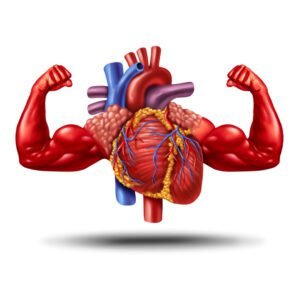
Health Benefits:
- No Hangover: Non-alcoholic beers contain less than 0.5% alcohol, significantly reducing the risk of hangovers compared to traditional beers, which can lead to dehydration and other unpleasant symptoms.
- Hydration: These beers are composed of approximately 95% water and contain electrolytes, making them effective for hydration. Studies have shown that non-alcoholic beer can help maintain hydration levels, especially during physical activities.
- Bone Health: Non-alcoholic beer contains silicon, which is beneficial for bone density. Research indicates that moderate consumption can help increase bone mineral density, particularly in older adults and post-menopausal women.
- Cardiovascular Benefits: Moderate consumption of non-alcoholic beer may support heart health due to the presence of polyphenols from hops, which can help reduce blood pressure and inflammation.
- Nutritional Value: Non-alcoholic beers are rich in vitamins (especially B vitamins), minerals (like calcium and potassium), and antioxidants. These nutrients contribute to overall health and can support functions such as red blood cell formation and muscle health.
Other Benefits:
- Post-Exercise Recovery: The sodium, fluids, and carbohydrates in non-alcoholic beer can aid in recovery after strenuous exercise.
- Reduced Risk of Osteoporosis: The silicon content may help increase bone mineral density.
- Lower Caloric Intake: NA beers typically contain fewer calories than traditional beers, making them a better option for those monitoring their caloric intake. A standard non-alcoholic beer has around 80 calories, compared to about 100 calories for a regular beer.
- Social Inclusion: NA beers allow individuals to participate in social drinking without the effects of alcohol, helping maintain social connections without compromising health or sobriety.
- Improved Sleep: Unlike alcoholic beverages, which can disrupt sleep patterns, NA beers may promote better sleep quality. Hops, a common ingredient, have sedative properties that can aid relaxation and improve sleep.
- Support for Alcohol Reduction: For those looking to reduce alcohol consumption, non-alcoholic beer can serve as a transitional beverage, allowing individuals to enjoy the taste of beer without the associated risks of alcohol.
- Overall Refreshment: Many find non-alcoholic beers to be more refreshing than traditional beers, as they often contain ingredients that provide a true sense of rejuvenation without the negative effects of alcohol.
How Do The Flavors And Ingredients In Non Alcoholic Brews Compare To Regular Beers?
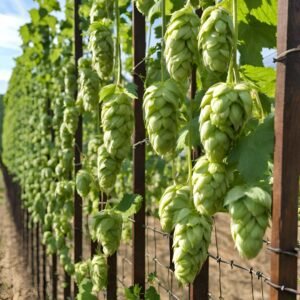
Here’s how the flavors and ingredients compare:
Ingredients:
As mentioned earlier, beer without alcohol use the same four main ingredients as regular beers:- Water
- Malted grains (usually barley)
- Hops
- Yeast
Flavor Profile:
When done well, non-alcoholic beers can closely mimic the flavors of traditional beers:- They aim to recreate the hoppy bitterness, malty sweetness, and aromatic qualities of traditional beers.
- Advanced brewing techniques have significantly improved the taste in recent years, allowing non-alcoholic options to more closely match their alcoholic counterparts.
- The lack of alcohol can make non-alcoholic beers taste slightly less “full-bodied” compared to regular beers. This may be why I don’t experience that bloated feeling from non-alc beer. Just a thought.
- Some may have a slightly sweeter profile due to residual sugars that weren’t fermented into alcohol.
Brewing Process Differences:
To achieve a non-alcoholic product, brewers use special techniques:- Controlled fermentation: Limiting the fermentation process to prevent alcohol production.
- Dealcoholization: Removing alcohol after normal fermentation through processes like steam distillation or reverse osmosis.
- Special yeasts: Using strains that produce very little alcohol during fermentation.
Additional Flavorings:
Some non-alcoholic beers may incorporate natural flavorings to enhance taste:- This can help compensate for flavor compounds typically provided by alcohol.
- It allows brewers to create unique flavor profiles or mimic specific beer styles more closely.
Variety of Styles:
Like regular beers, non-alcoholic options come in various styles:- Craft breweries are increasingly producing non-alcoholic versions of popular styles like IPAs, stouts, and lagers.
- This allows consumers to enjoy a range of flavor profiles similar to traditional craft beers.
What Are Some Popular Brands Low Carb NA Beer?
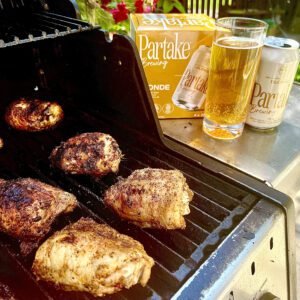
Having hunted the shelves in search of non alcoholic beers that are low in carbs and sugar, I’ve discovered that IPAs seem to have the least amount.
Here are some IPA brands available in the US and some in Canada:
Partake Brewing IPA:
- Type: Dealcoholized Ale Beer
- Available in USA and Canada
- Alcohol Content: Less than 0.5% ABV
- Calories: 10 per 355 ml can
- Carbohydrates: 0 g per 355 ml can
- Sugars: 0 g per 355 ml can
President’s Choice IPA:
- Type: Dealcoholized Ale Beer
- Available in Canad
- Alcohol Content: Less than 0.5% ABV
- Calories: 40 per 355 ml can
- Carbohydrates: 2 g per 355 ml can
- Sugars: 0 g per 355 ml can
- Taste Profile: Citrus and Pleasantly Bitter
Surreal Brewing Company Natural Bridges Kölsch Style:
- Type: Dealcoholized Ale Beer
- Available in USA
- Alcohol Content: Less than 0.5% ABV
- Calories: 17 per 355 ml can
- Carbohydrates: 2.8 g per 355 ml can
- Sugars: 0 g per 355 ml can
Crux NoMo River Refresher IPA:
- Type: Dealcoholized Ale Beer
- Alcohol Content: Less than 0.5% ABV
- Calories: 30 per 355 ml can
- Carbohydrates: 3 g per 355 ml can
- Sugars: 0 g per 355 ml can
- Taste Profile: Citrus and tropical
Crux NoMO Sunset Summit IPA:
- Type: Dealcoholized Ale Beer
- Alcohol Content: Less than 0.5% ABV
- Calories: 30 per 355 ml can
- Carbohydrates: 3 g per 355 ml can
- Sugars: 0 g per 355 ml can
- Taste Profile: Tropical
How Can NA Beers Enhance Social Gatherings Or Celebrations?

Here are several ways in which they contribute positively to social experiences:
Inclusivity in Social Settings:
- Catering to Diverse Preferences: Non-alcoholic beers allow individuals who may abstain from alcohol for various reasons—such as health, personal choice, or religious beliefs—to participate fully in social events. This inclusivity fosters a welcoming environment where everyone can enjoy the occasion without feeling marginalized.
- Encouraging Social Interaction: By providing non-alcoholic options, hosts can create a more balanced atmosphere that encourages conversations and connections among guests, regardless of their drinking preferences. This aligns with the growing trend of mindful drinking, where the focus shifts from intoxication to social engagement.
Health and Wellness Focus:
- Health-Conscious Choices: As awareness of health and wellness increases, many individuals are seeking to reduce their alcohol intake. Non-alcoholic beers offer a flavorful alternative that allows people to enjoy the taste of beer without the negative effects of alcohol, such as hangovers or impaired judgment. This shift is particularly appealing to younger generations, who prioritize health and wellness in their lifestyle choices.
- Mindful Drinking Movements: Events that incorporate non-alcoholic options often align with initiatives like “Dry January” or “Sober October,” encouraging participants to explore alcohol-free alternatives. This cultural movement promotes healthier social habits and reduces the stigma associated with not drinking alcohol.
Enhanced Beverage Options:
- Craft Mocktails and Sophisticated Alternatives: The rise of craft mocktails and high-quality non-alcoholic beers has transformed the beverage landscape. These drinks are crafted with the same care and creativity as their alcoholic counterparts, featuring unique flavors and presentations that enhance the overall experience of social gatherings.
- Improved Taste and Quality: Advances in brewing technology have led to non-alcoholic beers that closely mimic the flavors and mouthfeel of traditional beers, making them more appealing to consumers. This improvement in quality helps to normalize the choice of non-alcoholic beverages at events, moving away from the notion of them being mere “apology serves” for non-drinkers
What Tips Do You Have For Pairing NA Beers With Food For The Best Flavor Experience?
Pairing non-alcoholic beer with food can enhance your dining experience by complementing and contrasting flavors.
Here are some effective tips for achieving the best flavor combinations:
General Principles:
- Match Intensity: Ensure that the flavor intensity of the beer matches that of the dish. Robust dishes, such as grilled meats, pair well with beers that have strong flavors, while lighter dishes, like salads, are better suited to milder beers.
- Consider Flavor Profiles: Different types of non-alcoholic beers have unique flavor profiles that can enhance specific dishes. For example:
- Light Lagers: Pair well with grilled chicken and light salads due to their crisp and refreshing taste.
- Wheat Beers: Ideal for seafood dishes, particularly those with lemon-butter sauce, as their effervescence complements delicate flavors.
- Amber Ales: Work well with barbecue pork and grilled vegetables, as their caramel notes enhance the smokiness of the meat.
- Explore Complementary and Contrasting Flavors: Look for flavors that either complement or contrast with those in your dish. For instance, a hoppy beer can enhance spicy dishes, while a sweet beer can balance out savory flavors.
Additional Tips:
- Bitterness and Fat: Bitterness in beer can cut through the richness of fatty dishes, making it a good match for proteins.
- Experimentation: Don’t hesitate to try different combinations to discover what works best for your palate. The journey of pairing is about exploration and personal preference.
What Keto and Low-Carb Dishes Work with Low-Carb NA Beer?
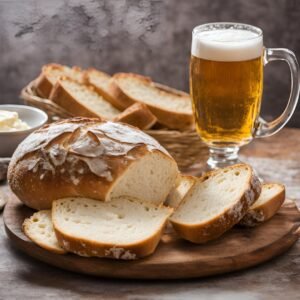
The dishes I’m recommending have non alcoholic wine notes. However, these dishes also work well with low sugar non alcoholic IPAs.
Here are some recipes:
Spicy Dishes:
The bitterness of IPAs complements and balances spicy foods, making them an excellent match for dishes like tacos, spicy sausage calzones, and chicken tikka masala. The hoppy bitterness can also enhance the flavors of spicy Asian dishes, such as curries and fried vegetables.
- Curry Chicken Quarters (Heart Healthy)
- Cajun Salmon (Heart Healthy)
- Chicken Pad Thai
- Bacon-Wrapped Chorizo
Fatty Foods:
IPAs are great with fried foods, as their carbonation cuts through the richness and greasiness. Consider pairing them with French fries, fried chicken, or fish and chips. The crispness of the beer helps cleanse the palate between bites.
Rich and Creamy and Cheesy Dishes:
IPAs can also work well with creamy sauces, as the bitterness helps tone down the richness. Foods like macaroni and cheese or creamy pasta dishes benefit from the refreshing qualities of the beer.
Pizzas:
Grilled Meats:
Grilled meats, especially those with a charred exterior, pair well with IPAs. The hoppy flavors can enhance the smoky notes from the grill. Try them with burgers, grilled chicken, or barbecue ribs.
Let’s talk salty…
Salty snacks, such as pretzels or chips, are perfect companions for IPAs. The beer’s bitterness balances the saltiness, making for an enjoyable snacking experience.
Non Alc IPA’s work nicely with salty pretzels enjoyed alone or with mustard.
I’m so excited to share that I’ve started an online membership site that teaches you how to make your own low carb sourdough breads and baked goods, including salty pretzels. They are so delicious and use Celtic salt. So not only is the pretzel itself low carb and healthy for your microbiome, but also provides essential trace minerals to your body from the salt. Here’s the website. Check it out:
Here are other recipes worth considering:
Citrus and Herb-Driven Dishes:
Dishes that incorporate citrus or fresh herbs, like ceviche or salads with vinaigrettes, pair well with the fruity and floral notes often found in IPAs. The bright flavors of the food enhance the hop characteristics of the beer.
Sweet:
IPAs can indeed pair well with sweet flavors, enhancing the overall tasting experience. Here are some food pairing suggestions that highlight the compatibility of sweet elements with IPAs:
- Korean Short Ribs
- Lazy Apple Butter Ribs
- Coconut Coasted Drumsticks
- Cinnamon Marmalade Chicken (Heart Healthy)
- Tuna Avocado Blackberry Salad (Hearty Healthy)
Can Alcohol-Free Beer Make Me Sick?
Potential Health Risks:
- Alcohol Content: Despite being labeled as “non-alcoholic,” these beers can contain up to 0.5% alcohol by volume (ABV). This small amount of alcohol may be problematic for certain individuals, such as those recovering from alcohol addiction, pregnant women, or people with specific health conditions that require complete abstinence from alcohol.
- Caloric and Sugar Content: Non-alcoholic beers often contain added sugars and can be high in calories, which might lead to weight gain and related health issues if consumed in large quantities. This can also cause feelings of nausea after consuming several beverages. Hunt for brands with low carbs per can.
- Allergic Reactions: Some individuals may experience headaches or other adverse reactions due to ingredients in non-alcoholic beer, such as gluten or other compounds like histamines or tyramine.
- Psychological Effects: For individuals recovering from alcohol use disorder, non-alcoholic beer might trigger cravings or a psychological relapse, as it mimics the experience of drinking regular beer. This can be a slippery slope for those in recovery.
What Is The Difference Between Non-Alc And Traditional Beer?
Non-Alcoholic Beer:
- Can contain up to 0.5% alcohol by volume (ABV) in the United States.
- Legally allowed to have trace amounts of alcohol.
- Often labeled as “non-alcoholic malt beverage” or “non-alcoholic brew” in the US.
Alcohol-Free Beer:
- Contains no detectable alcohol (0.0% ABV) according to US Food and Drug Administration regulations.
- Must have absolutely no measurable alcohol content to be labeled as “alcohol-free” in the US.
- In the UK, can contain up to 0.05% ABV and still be labeled as “alcohol-free”.
Labeling and Regulations:
Labeling regulations vary by country:- United States: “Non-alcoholic” and “alcohol-free” are not synonymous. Only products with no detectable alcohol can be labeled “alcohol-free”.
- United Kingdom: “Alcohol-free” or “zero-alcohol” can contain up to 0.05% ABV.
- European Union: “Alcohol-free” applies to beverages containing less than 0.5% ABV.
Production Methods:
Both non-alcoholic and alcohol-free beers are typically made using one of these methods:- Controlled fermentation
- Dealcoholization
- Dilution
- Simulated fermentation
Caution:
It’s important to note that some non-alcoholic beers may contain more alcohol than their labels claim. One study found that nearly 30% of beverages claiming to be non-alcoholic or low-alcohol contained more alcohol than stated, with some labeled 0.0% ABV containing up to 1.8% ABV.In summary, while both non-alcoholic and alcohol-free beers are designed to have very low or no alcohol content, alcohol-free beers are generally held to a stricter standard of containing no detectable alcohol, especially in the United States.Where Can I Buy Non-Alcoholic Beer?
You can buy non-alcoholic beer in both the U.S. and Canada through various online platforms and local retailers.
Here are some options:
Online Retailers:
- Proof No More
- Offers a wide selection of non-alcoholic beers, spirits, and wines, shipping across the U.S.
- Website: Proof No More
- NA Beer Club
- Provides a subscription service that delivers different craft non-alcoholic beers monthly to U.S. addresses.
- Website: NA Beer Club
- Athletic Brewing Co.
- Specializes in craft non-alcoholic beers with various styles available for online purchase.
- Website: Athletic Brewing
- Amazon
- A wide variety of non-alcoholic beers can be found on Amazon, including popular brands like Heineken 0.0 and Samuel Adams.
- Website: Amazon Non-Alcoholic Beer
- Designated Drinks
- A Canadian retailer offering a large selection of non-alcoholic beers with delivery options.
- Website: Designated Drinks
Local Retailers:
- Many grocery stores and liquor stores in both the U.S. and Canada now carry non-alcoholic beer. Look for sections dedicated to craft beer or specialty beverages.
These options should help you find a variety of non-alcoholic beers to purchase in both countries.
Is Non-Alcoholic Beer Safe For Pregnant Women?

What Other Non Alcoholic Wine Articles Might You Be Interested In?
- SIP SLIM: BEST NON ALCOHOLIC SPARKLING WINE HACK
- NON ALCOHOLIC SPARKLING WINE & LOW CARB SOURDOUGH DELIGHTS
- ONES SPARKLING ROSE & LEMON GINGER CODE
- BEST NON ALCOHOLIC WINE OPTIONS FOR THANKSGIVING
- 16 JAW DROPPING NON ALCOHOLIC WINE HEALTH BENEFITS
- NON ALCOHOLIC SPARKLING WINE WITH SCRABLED EGGS DELIGHT
I’m excited to share with you my good news… Introducing Sinless Sourdough – Where Ancient Art Meets Low Carb Science!

Stop sacrificing flavor for your health goals – our authentic heritage sourdough starters have been specially adapted for low-carb baking
Limited Time Offer: 82% OFF – Only $19.99 Today (Regular Price: $113)
Sinless Sourdough™ Starter + Membership Includes:
- Authentic Heritage Starter shipped directly to your door
- Complete Video Training Library showing you step-by-step how to create:
- Artisan boules and batards with delicious crispy crust and soft interior
- Crisp French baguettes for the dinner table or as crostini
- Chewy Montreal-style bagels that won’t spike your blood sugar
- German street pretzels with authentic alkaline crust
- Convenient everyday bread machine loaves for sandwiches
- Supportive Community of fellow low-carb bakers to share your journey
- Extensive Recipe Collection for using sourdough discard (nothing goes to waste!)
“After years of disappointing low-carb bread experiments, Sinless Sourdough changed everything. I’m enjoying real sourdough again without the carb guilt!” — Maria T.
“My family can’t tell the difference between these loaves and traditional bread. The starter is incredibly active and the results are amazing!” — James K.
🔥 CLAIM YOUR MEMBERSHIP NOW 🔥
Use code: Sinless82 at checkout Offer expires soon! Limited starter batches available
82% OFF TODAY FOR MEMBERSHIP
Sinless Sourdough™ Heritage Collection

Transform your low-carb baking with our Global Heritage Collection featuring unique starters from historic moments across continents. Each brings its own personality and flavor profile while maintaining excellent nutritional values—just 1g net carbs compared to 8-10g in traditional starters.
Choose from:
- 1849 San Francisco Gold Rush – Authentic California sourdough character
- 1898 Yukon Gold Rush – Subtle tanginess with notes of butter
- 1847 Oregon Trail – Rustic character with exceptional rise
- 1000-Year-Old Italian Monastery – Delicate complexity with ancient lineage
Each starter connects you to centuries of baking tradition while supporting your modern low-carb lifestyle. Our proprietary transformation process preserves their unique characteristics while adapting them for health-conscious baking.
When you purchase any Sinless Sourdough™ starter, you receive our comprehensive onboarding sequence teaching you exactly how to revive your dehydrated starter for perfect low-carb, high-protein results every time.
Click the link:
SINLESS STARTER SHOP
🍞 START YOUR LOW-CARB SOURDOUGH JOURNEY TODAY! 🍞
Medical Studies and Reviews on Sourdough
Here they are:
Does Sourdough Bread Provide Clinically Relevant Health Benefits?
The Sourdough Microbiome
Study Of Sourdough Starter Microbiome To Boost Bread Quality and Safety
Sourdough Microbiome Comparison and Benefits
Effect of Breadmaking Process on In Vitro Gut Microbiota Parameters in Irritable Bowel Syndrome
Nutritional Benefits of Sourdough; Systematic Review
Sourdough-leavened bread improves postprandial glucose and insulin plasma levels in subjects with impaired glucose tolerance
Use of sourdough in low FODMAP baking
A novel formulation of sourdough bread enriched with plant sterols and high-fibre inulin improves metabolic control in type 2 diabetes
Impact of sourdough fermentation on appetite and postprandial metabolic responses – a randomised cross-over trial with whole grain rye crispbread
Disclaimer:
All information provided on this website regarding the health benefits of sourdough low carb bread is intended for educational purposes only. The content presented is not meant to be taken as specific medical advice for any individual. It should not be considered a replacement for professional medical guidance or treatment. If you have any health concerns, especially related to diabetes, pre-diabetes, or any other medical condition, please consult with a healthcare professional immediately.
- UNUSUAL KETO INSTANT POT RECIPES FOR 2025 - April 27, 2025
- Boost Your Keto Diet with These Non-Alcoholic Wine Hacks - April 27, 2025
- 10 Unique & Healthy Mocktails You Need to Try - April 27, 2025


